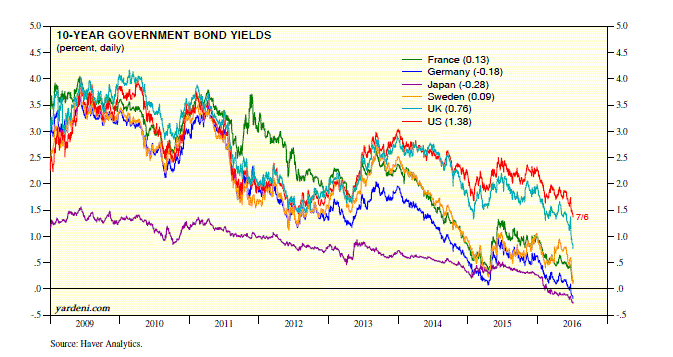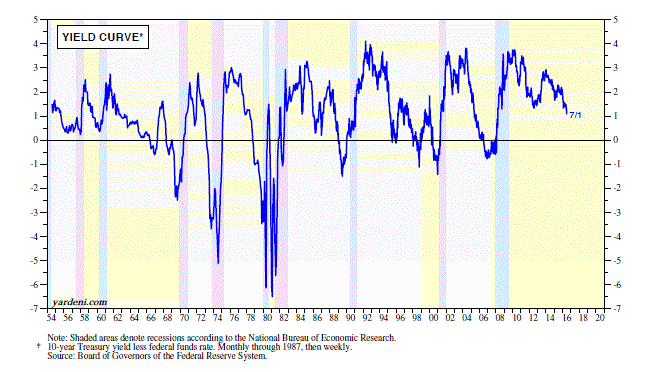
The ongoing plunge in bond yields to new record lows around the world is starting to become worrisome. The concern is that the bond market is foreshadowing a global recession. Here is the latest roundup of a selection of key 10-year government bond yields around the world from highest to lowest: US (1.38%), Italy (1.25), Spain (1.19), UK (0.76), France (0.13), Sweden (0.09), Germany (-0.18), and Japan (-0.28).
The yield curve is widely viewed as a good business cycle indicator. Indeed, it is one of the 10 components of the Index of Leading Economic indicators in the US. Yield curves around the world are flattening, though they haven’t inverted just yet, which is widely viewed as a sure sign of an imminent recession. The yield spread between 10-year US Treasury bond and the two-year note is down to 81bps, the lowest since November 14, 2007. The former is falling faster than the latter.
Following the Brexit vote, the federal funds rate in the futures market 12 months from now fell 17bps to 0.42%, implying no change in Fed policy over this period.
This is certainly consistent with my forecast since the end of last year that one-and-done or even none-and-done were the most likely outlooks for rate-hiking this year. It also has contributed to the bond rally, especially in the US.
In the past, the Fed rarely gave much weight to overseas economic developments. Now that the Fed seems to be doing so, the globalization of US monetary policy also has globalized the US bond market.
I’m not convinced that the bond market is signaling a recession in the US or even in the global economy. It is confirming that overseas central banks will continue to pursue their ultra-easy monetary policies, and that the Fed will postpone additional rate hikes.
Undoubtedly, the negative official interest rates of the ECB and BOJ are major contributors to the race to zero and below in bond yields. So is the ECB’s corporate bond-buying program, which started in June, and may be hard to implement given that the reach-for-yield mania is back with a vengeance, with everyone swooping up bonds and putting them away.
The problem is that the flattening of the yield curve around zero percent is bad news for banks and other financial intermediaries.
Let’s review some of the latest bond-related economic news:
(1) Global economy is weak. Low bond yields are justified by the lackluster pace of global economic activity. The global economy is still growing, though slowly. I doubt that Brexit will cause a global recession, but it does increase the vulnerability of the global economy to a downturn should more bad stuff happen.
If Brexit leads to the meltdown of the Italian banks or to “Quitaly,” then Europe could fall into a recession and drag down the global economy.
The latest global composite PMI was 51.1 during June, unchanged from the previous month. The M-PMI component edged up from 50.0 to 50.4, while the NM-PMI edged down from 51.4 to 51.3. Interestingly, the composite index is a bit higher in developed economies at 51.5 than in emerging economies at 50.1.
The Eurozone’s composite has been relatively stable around 53.0 for the past five months. The volume of retail sales in the Eurozone is up 1.6% y/y in May, and is back near the previous record high during 2007. All of the above is consistent with a scenario of global secular stagnation rather than a recession.
(2) US economy is mixed. Another upbeat indicator popped up on Friday in the US. The ISM M-PMI rose from 51.3 during May to 53.2 during June. Leading the way were solid readings in the new orders and production components, at 57.0 and 54.7 respectively.
In May, the ATA truck tonnage index rose 2.7% m/m after spiking up in March and down in April. The 12-month average rose to yet another new record high in May. The bad news is that non-defense capital goods orders excluding aircraft was down 3.8% y/y in May to the lowest since April 2011.

